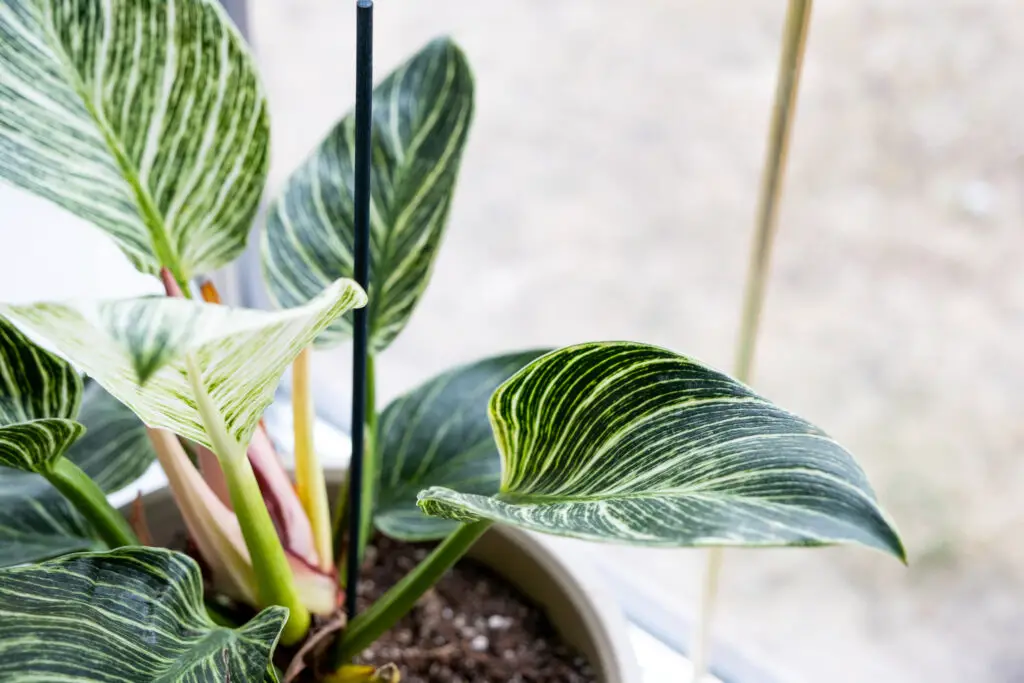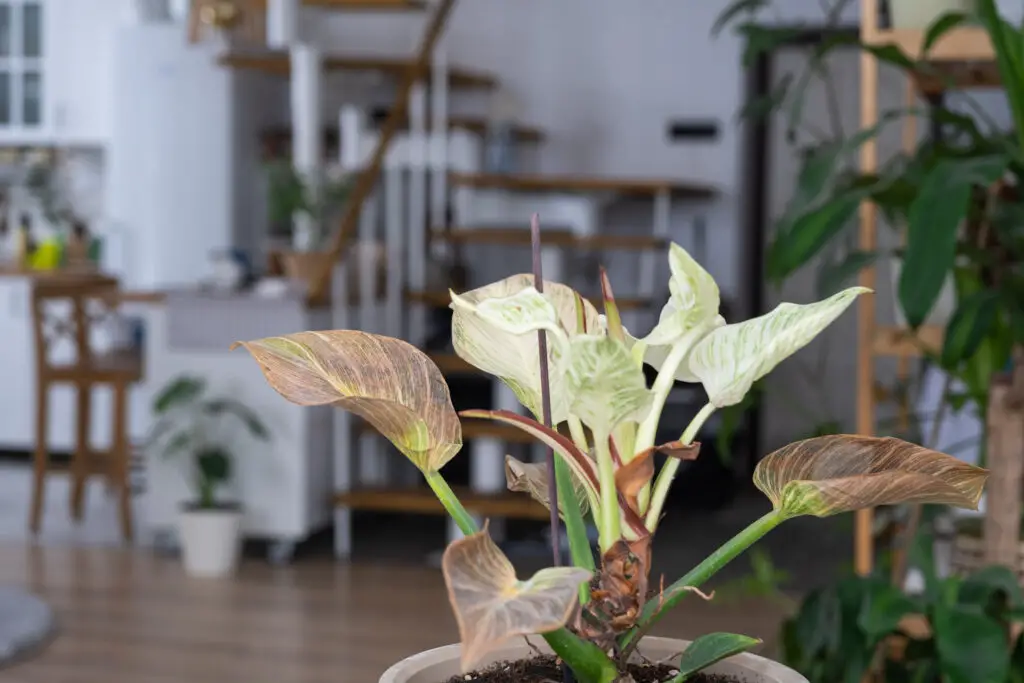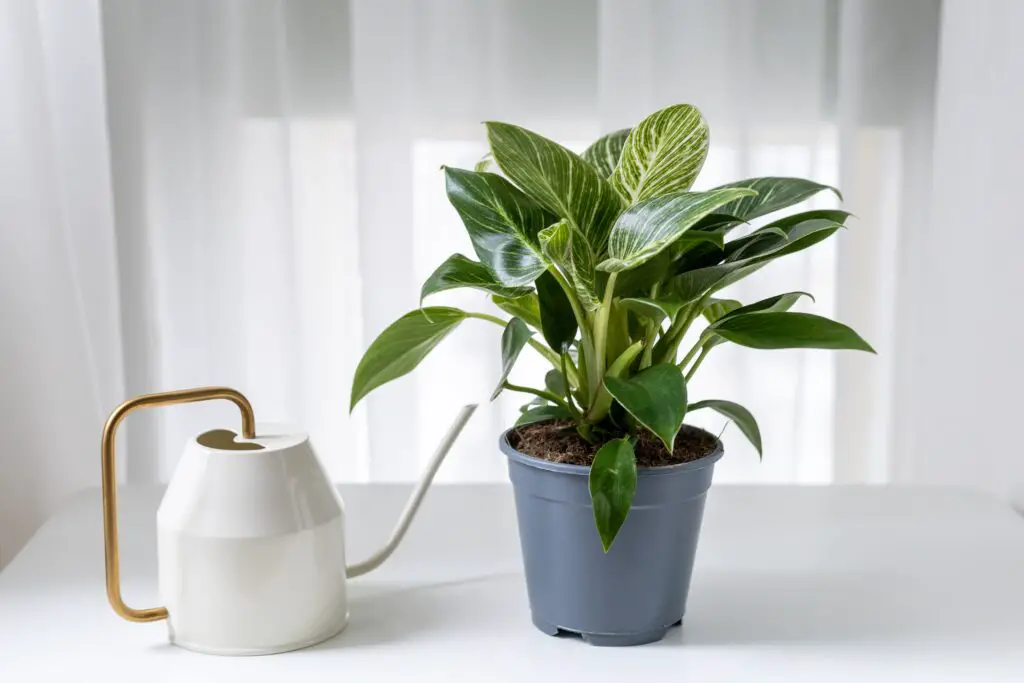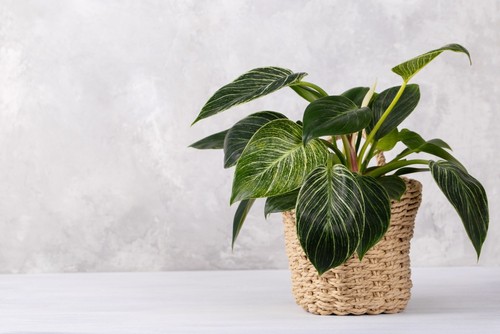Philodendron Birkin is a popular houseplant that is loved for its stunning white and green leaves. However, sometimes the leaves of a Philodendron Birkin can start to turn brown, which can be a concern for plant owners.
Brown leaves on a Philodendron Birkin can be caused by a variety of factors, including improper watering, pests, and disease.
Understanding the causes of brown leaves on a Philodendron Birkin is essential for proper care of the plant. Overwatering or underwatering can cause the leaves to turn brown, as can pests like spider mites and mealybugs.
Fungal and bacterial diseases can also cause brown spots on the leaves. By identifying the cause of the brown leaves, plant owners can take the necessary steps to revive their Philodendron Birkin and prevent further damage.
Key Takeaways on Philodendron Birkin White Leaves Turning Brown
- Proper care is essential for maintaining healthy Philodendron Birkin leaves.
- Brown leaves on a Philodendron Birkin can be caused by a variety of factors, including improper watering, pests, and disease.
- Identifying the cause of brown leaves is crucial for reviving a Philodendron Birkin and preventing further damage.
Check out these other posts:
- Perlite Turning Brown
- Peperomia Leaves Turning Brown and Falling Off
- Peace Lily Leaves Turning Brown?
Understanding Philodendron Birkin

Philodendron Birkin is a stunning indoor plant that has become increasingly popular among plant enthusiasts. This tropical plant is known for its unique white pinstripes that run down the center of its dark green leaves.
It is a self-heading plant, which means it does not climb or trail like other philodendrons. Instead, it has a thick, upright, and self-supporting stem, giving it a more tree-like appearance.
Philodendron Birkin is a variegated plant, which means it has different colored zones on its leaves. The amount of variegation can vary from plant to plant, and those with more white leaves will need brighter light to thrive than those with predominantly green leaves.
The variegation comes from a chimeric mutation that occurred spontaneously from the Philodendron Rojo Congo.
Philodendron Birkin is an excellent indoor plant. It is relatively easy to care for and can thrive in a variety of lighting conditions. However, it is essential to keep it out of reach of children and pets, as all parts of the plant are toxic when ingested.
Philodendron Birkin – 5 Common Problems
Philodendron Birkin is a popular houseplant known for its beautiful white and green leaves. However, sometimes the leaves can turn brown, which can be a sign of an underlying problem. In this section, we will explore the most common causes of brown leaves on Philodendron Birkin plants.
1. Overwatering and Underwatering
Overwatering and underwatering are two of the most common causes of brown leaves on Philodendron Birkin plants. Overwatering can lead to root rot, which can cause the leaves to turn brown and fall off. On the other hand, underwatering can cause the leaves to dry out and turn brown at the tips.
To avoid overwatering or underwatering your Philodendron Birkin, it is important to water it only when the top inch of the soil is dry. You can also use a moisture meter to determine when to water your plant.
2. Exposure to Direct Sunlight
Philodendron Birkin plants prefer bright, indirect light. Exposure to direct sunlight can cause the leaves to burn and turn brown. If your plant is exposed to direct sunlight, move it to a spot with bright, indirect light.
3. Temperature and Humidity Issues

Philodendron Birkin plants prefer warm temperatures and high humidity. Low humidity levels can cause the leaves to dry out and turn brown. To increase humidity levels, you can mist your plant or place a humidifier nearby.
4. Nutrient Deficiency and Overfertilization
Nutrient deficiency and overfertilization can also cause the leaves of Philodendron Birkin plants to turn brown. If your plant is not getting enough nutrients, the leaves may turn brown and fall off. Overfertilization, on the other hand, can cause the leaves to burn and turn brown.
To avoid nutrient deficiency or overfertilization, it is important to fertilize your plant only when it is actively growing. Use a balanced fertilizer and follow the instructions on the label.
5. Disease and Pest Infestation
Disease and pest infestation can also cause the leaves of Philodendron Birkin plants to turn brown. Bacterial or fungal infections can cause brown spots on the leaves, while pests such as spider mites or mealybugs can cause the leaves to turn brown and fall off.
To prevent disease and pest infestation, it is important to keep your plant clean and free from debris. You can also use an insecticidal soap or neem oil to treat pest infestations.
In summary, brown leaves on Philodendron Birkin plants can be caused by a variety of factors, including overwatering, underwatering, exposure to direct sunlight, temperature and humidity issues, nutrient deficiency and overfertilization, and disease and pest infestation.
By addressing these issues, you can help keep your Philodendron Birkin healthy and happy.
Proper Care for Philodendron Birkin

Philodendron Birkin is a beautiful houseplant with dark green leaves and white pinstripes. While it is a low-maintenance plant, it still requires proper care to thrive and avoid issues like white leaves turning brown. Here are some guidelines for caring for your Philodendron Birkin.
Watering and Soil Requirements
Philodendron Birkin prefers well-drained soil that is rich in organic matter. It is important to water the plant when the top inch of soil is dry to the touch. Overwatering can lead to root rot, which can cause the leaves to turn brown. It is recommended to use a moisture meter to check the soil’s moisture level before watering.
Make sure to use a pot with drainage holes to allow excess water to drain out. When watering, make sure to water the soil directly and avoid getting water on the leaves, which can cause fungal diseases.
Light and Temperature Preferences
Philodendron Birkin prefers bright indirect light, but it can also tolerate low light conditions. Direct sunlight can burn the leaves, so it is important to avoid exposing the plant to direct sunlight.
The plant prefers warm temperatures between 60-85°F (16-30°C). It is important to avoid exposing the plant to cold drafts or sudden temperature changes, which can cause stress and lead to brown leaves.
Pruning and Fertilization
Pruning is important to maintain the plant’s shape and promote healthy growth. Dead or yellowing leaves should be removed promptly to prevent the spread of disease. It is also recommended to prune the plant in the spring to encourage new growth.
Fertilization is important to provide the plant with the nutrients it needs for healthy growth. Use a balanced fertilizer every 2-4 weeks during the growing season (spring and summer) and reduce feeding during the winter months.
Pest and Disease Management
Philodendron Birkin is susceptible to pests like spider mites, mealybugs, and scale insects. Regularly inspect the plant for signs of infestation and treat promptly with insecticidal soap or neem oil.
Fungal diseases can also affect the plant, especially if the leaves are exposed to excess moisture. To prevent fungal diseases, make sure to water the soil directly and avoid getting water on the leaves. Good air circulation and proper ventilation can also help prevent fungal diseases.
Reviving a Philodendron Birkin with Brown Leaves

Philodendron Birkins are beautiful houseplants that can add a tropical touch to any indoor space. However, when the leaves of a Philodendron Birkin start turning brown, it can be a sign that the plant is stressed and in need of some care.
In this section, we will explore some of the common reasons why a Philodendron Birkin’s leaves turn brown and how to revive the plant.
Addressing Overwatering and Root Rot
Overwatering is a common cause of brown leaves in Philodendron Birkins. When the soil is too wet for too long, the roots can start to rot, which can lead to brown leaves and wilting.
To address overwatering and root rot, it is important to first check the soil moisture level. If the soil is wet, allow it to dry out before watering again. It is also important to ensure that the pot has proper drainage to prevent water from accumulating at the bottom.
If the root rot has already set in, it may be necessary to repot the plant in fresh, well-draining soil. When repotting, carefully remove any damaged roots and disinfect the pot to prevent the spread of bacterial diseases.
Correcting Light and Temperature Issues
Philodendron Birkins thrive in bright, indirect light. If the plant is not getting enough light, the leaves may turn brown and the plant may start to wilt. On the other hand, if the plant is getting too much direct sunlight, it can lead to sunburn and brown spots on the leaves.
To correct light and temperature issues, it is important to find the right balance. Move the plant to a location with bright, indirect light and away from any direct sunlight. If the room is too cold, consider moving the plant to a warmer location or using a space heater.
Managing Nutrient and Humidity Problems
A lack of nutrients or humidity can also cause brown leaves in Philodendron Birkins. If the plant is not getting enough nutrients, it may start to yellow and wilt. If the air is too dry, the leaves may start to brown and curl.
To manage nutrient and humidity problems, it is important to fertilize the plant regularly with a balanced fertilizer. It is also helpful to use a pebble tray or humidifier to increase the humidity around the plant. If the leaves have calcium oxalate crystals, it is important to handle the plant with care as the crystals can be toxic.
Dealing with Disease and Pests
Disease and pest infestations can also cause brown leaves in Philodendron Birkins. Spider mites, mealybugs, and aphids are common pests that can cause brown spots on the leaves. Bacterial diseases and leaf blight can also cause brown spots and yellowing.
Frequently Asked Questions

Why are my Philodendron Birkin’s white leaves turning brown?
There are several reasons why the white leaves of a Philodendron Birkin may turn brown. One of the most common reasons is underwatering or overwatering.
The soil should always be slightly moist, but not waterlogged. Another reason could be low humidity levels, which can cause the leaves to dry out and turn brown. Finally, exposure to direct sunlight can also cause the leaves to turn brown.
How can I prevent my Philodendron Birkin’s new leaves from rotting?
To prevent new leaves from rotting, it is important to ensure that the soil is well-draining and not waterlogged. Overwatering can cause the roots to rot, which can lead to the new leaves rotting as well. Additionally, it is important to avoid getting water on the leaves, as this can also cause them to rot.
What can I do to keep my Philodendron Birkin’s leaves more white?
To keep your Philodendron Birkin’s leaves more white, it is important to ensure that the plant is getting enough light.
However, it is also important to avoid exposing the plant to direct sunlight, as this can cause the leaves to turn brown. Additionally, maintaining high humidity levels can help to keep the leaves looking healthy and white.
Is it normal for Philodendron Birkin to revert?
Yes, it is normal for Philodendron Birkin to revert. This means that the plant may start producing leaves without the white variegation.
This can happen if the plant is not getting enough light or if it is not getting the right nutrients. If you want to maintain the white variegation, it is important to ensure that the plant is getting enough light and nutrients.
What should I do if my Philodendron Birkin’s new leaf is stuck?
If your Philodendron Birkin’s new leaf is stuck, it is important to avoid pulling on it, as this can damage the plant. Instead, it is best to wait until the leaf has fully unfurled on its own. If the leaf is taking a long time to unfurl, it may be a sign that the plant is not getting enough light or nutrients.
Why are my Philodendron Birkin’s leaves turning yellow and brown?
Yellow and brown leaves on a Philodendron Birkin can be a sign of several issues. Overwatering or underwatering can cause the leaves to turn yellow or brown.
Additionally, exposure to direct sunlight or low humidity levels can also cause the leaves to turn yellow or brown. Finally, pests or diseases can also cause the leaves to turn yellow or brown.

Hey, I’m Lisa and I’ve been an avid gardener for over 30 years. I love writing, talking and living in the garden! Feel free to connect with me on my socials below


